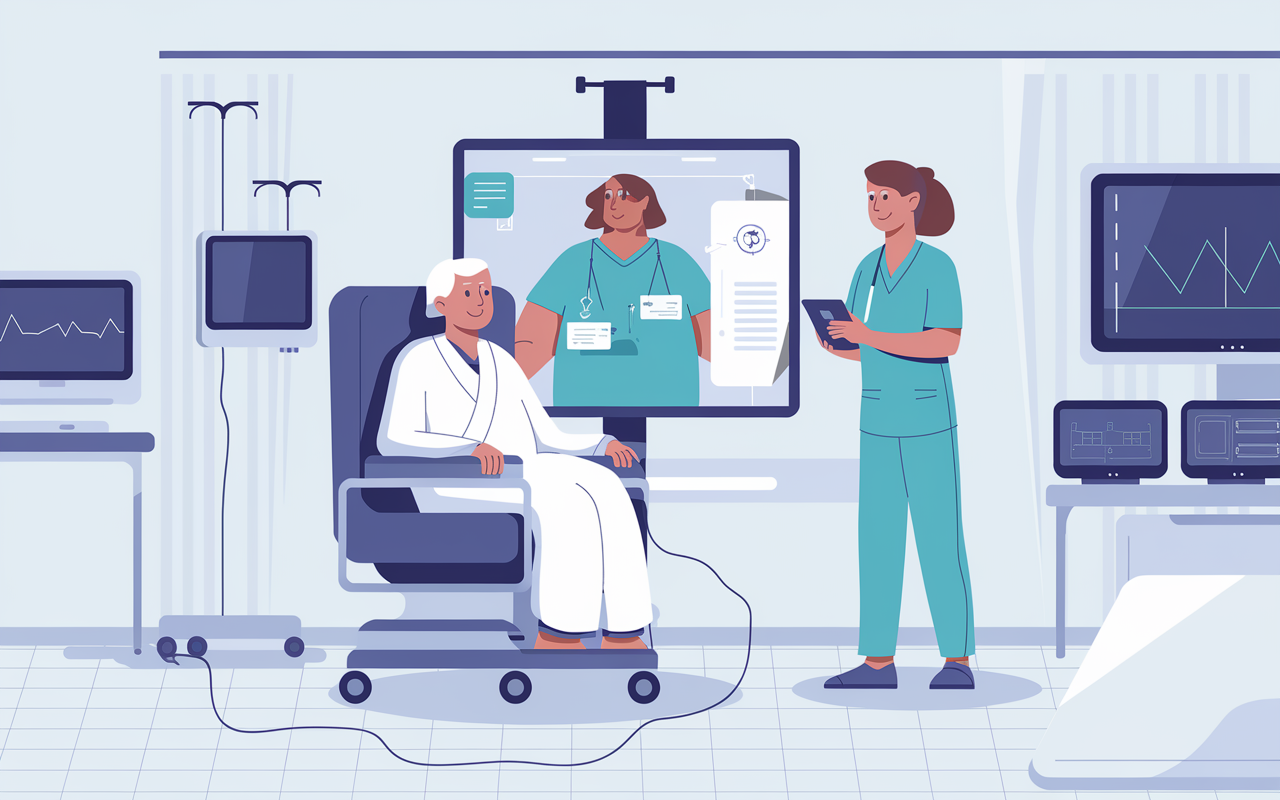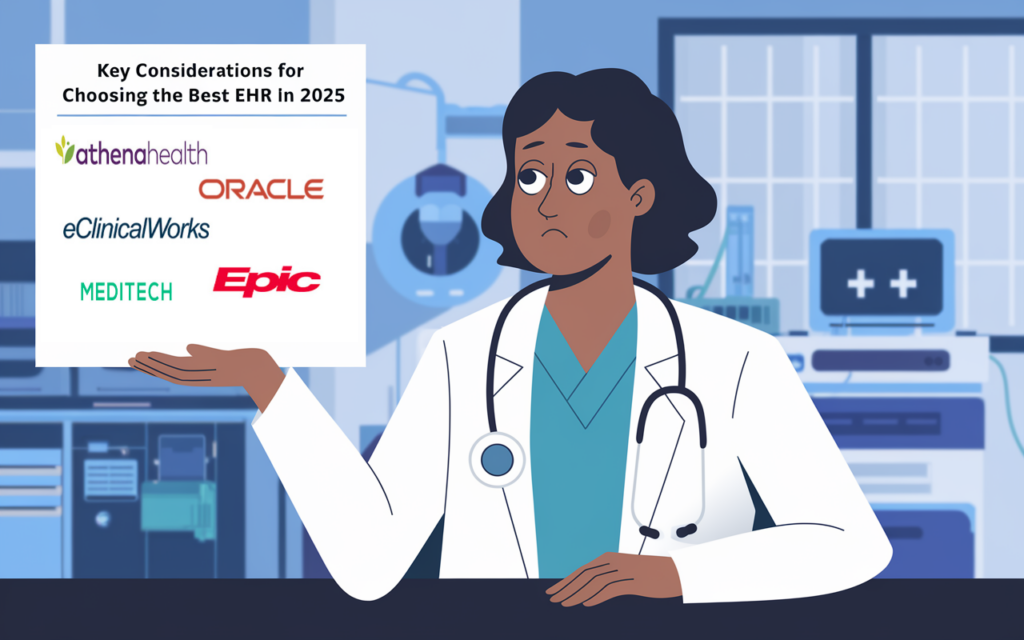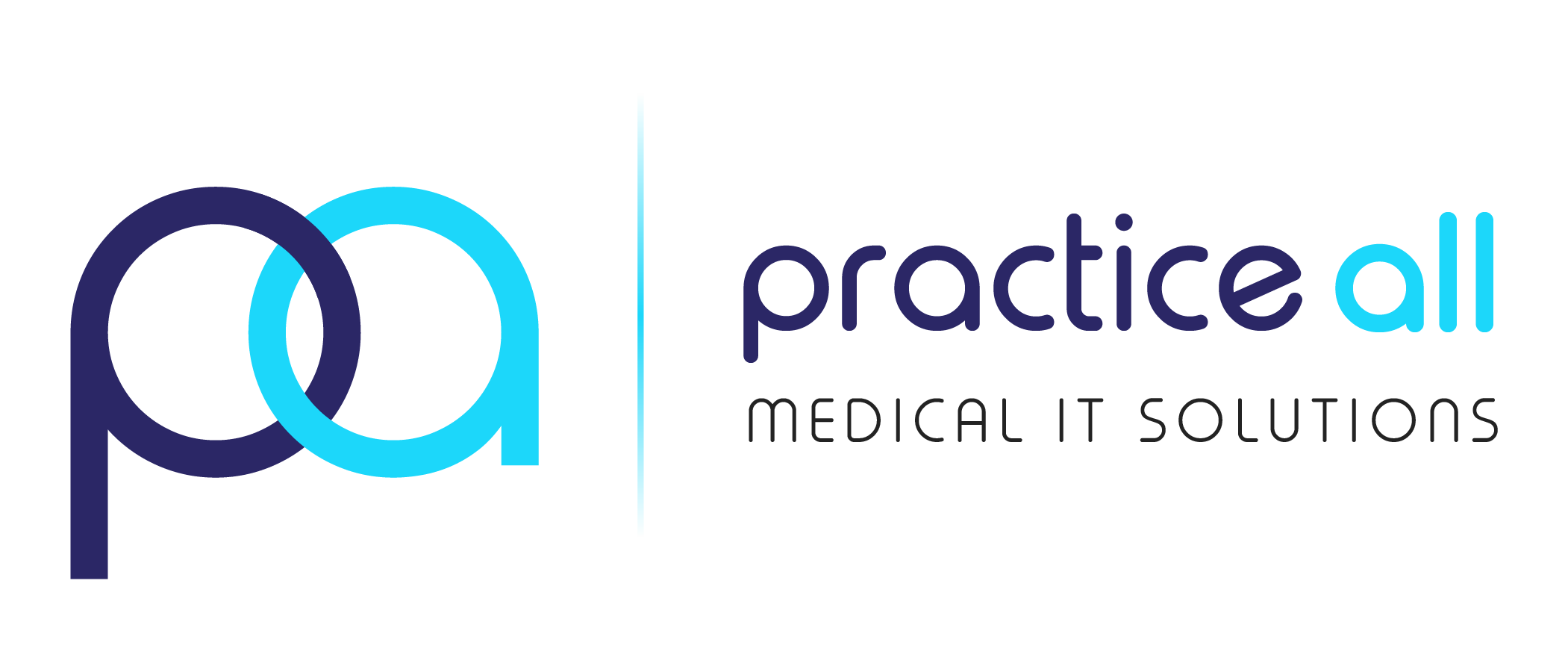EHR Shopping in 2025: Avoid the Nightmares, Find Your Dream EMR
Ah, EHR shopping. The digital equivalent of a root canal for many healthcare professionals. But fear not, intrepid doctor! It’s 2025, and the days of clunky interfaces and soul-crushing data entry are (mostly) behind us. You’re about to embark on a quest to find the Holy Grail of medical software—an EHR that won’t make you want to hurl your computer out the window. In this guide, we’ll navigate the treacherous waters of modern EMR solutions, helping you separate the gems from the duds. So grab your metaphorical machete, and let’s hack through the jungle of features, integrations, and buzzwords to find your practice’s perfect match.
The Evolving Landscape of EHR/EMR Solutions

From Digital Filing Cabinets to AI-Powered Health Wizards
Remember when EHRs were just glorified digital filing cabinets? Well, buckle up, buttercup, because by 2025, these systems will be so smart, they might just diagnose your patients before you do. According to industry projections, the global EHR market is set to hit a whopping $47 billion, proving that digital health is hotter than a fever of 103°F.
Cloud Nine and AI Divine
Gone are the days of clunky on-premise systems. The future is in the clouds, baby! Cloud-based EHRs are taking over faster than a viral TikTok dance, offering scalability that would make Jack’s beanstalk jealous. And let’s not forget about AI—it’s not just for creepy chatbots anymore. These systems will be diagnosing rare diseases and predicting health trends like a modern-day Nostradamus, but with better accuracy and fewer cryptic quatrains.
Interoperability: The Holy Grail of Healthcare
If there’s one thing that gets healthcare professionals more excited than free pizza in the break room, it’s interoperability. By 2025, we might finally achieve the dream of seamless data exchange between different healthcare systems. Imagine a world where you don’t have to play telephone with five different offices to get a patient’s complete history. It’s enough to bring a tear to your eye, isn’t it?
The Rise of the Machines (But in a Good Way)
Automation is set to revolutionize RCM (Revenue Cycle Management), making claims processing smoother than a well-oiled stethoscope. AI and machine learning will be prioritizing claims, reducing manual intervention, and probably making better coffee than the ancient machine in the staff room. Just don’t be surprised if your EHR starts asking for a raise.
Key Considerations for Choosing the Best EHR in 2025

Ah, the joys of EHR shopping in 2025! It’s like picking a new smartphone, but with more acronyms and fewer cat videos. Let’s dive into the digital rabbit hole of healthcare tech, shall we?
Features That’ll Make You Go “Ooh!”
First things first, you’ll want an EHR that does more than just store patient data. Look for systems with online booking, because nothing says “modern practice” like patients scheduling appointments while binge-watching their favourite shows. And don’t forget about telemedicine functionality—because sometimes, pants are optional (for patients, not you).
Integration: The Digital Glue
Your EHR should play nice with others. Ensure it can integrate seamlessly with other healthcare systems, like that one lab that always sends results in wingdings font. Real-time data exchange is crucial, unless you enjoy playing telephone with patient info (spoiler: you don’t).
User-Friendly or User-Frenemy?
Remember, an EHR should be your digital sidekick, not your nemesis. Look for systems with intuitive interfaces that don’t require a PhD in computer science to navigate. Bonus points if it doesn’t make your staff want to throw their computers out the window.
The Price Tag Tango
Let’s talk money, honey. Consider the total cost of ownership, including those sneaky ongoing fees. Sure, that fancy EHR might cost an arm and a leg, but think of all the time you’ll save not deciphering your own handwriting!
Remember, choosing an EHR is like finding a life partner—it should complement your practice, grow with you, and hopefully not crash during important moments. Happy hunting!
Interoperability: The Cornerstone of Modern EHR Systems
The Holy Grail of Healthcare IT
Ah, interoperability—the buzzword that makes healthcare IT professionals swoon and doctors roll their eyes. But hold onto your stethoscopes, folks, because this isn’t just another tech fad. Interoperability in healthcare is the superhero we’ve been waiting for, swooping in to save us from the nightmare of siloed data and fragmented patient care.
Imagine a world where patient information flows as smoothly as your morning coffee. No more faxing records (because it’s not 1995, people), no more playing telephone with specialists, and no more patients lugging around binders full of medical history. It’s not a fever dream—it’s the promise of true interoperability.
The Four Horsemen of the Interoperability Apocalypse
But wait, there’s more! Interoperability isn’t just one thing—it’s a whole squad. According to the experts, there are four levels of this digital nirvana:
- Foundational: The “can you hear me now?” of data exchange.
- Structural: When your data puts on its fancy pants and gets all standardized.
- Semantic: Everyone speaks the same language, and it’s not Latin.
- Organizational: The grown-up table where policies and governance play nice.
The Promised Land of Interoperable EHRs
Now, you might be thinking, “Great, another tech thing to learn.” But hear us out—the benefits are sweeter than a lollipop after a flu shot. Hospitals that have embraced interoperability are seeing some serious perks:
- Over 60% are now electronically sending, receiving, and integrating care summaries faster than you can say “HIPAA compliance.”
- A whopping 62% have patient info from outside sources available at the point of care. No more “the dog ate my medical records” excuses!
- Small and rural hospitals are catching up, proving that interoperability isn’t just for big-city folks with fancy lattes.
So, when you’re shopping for that shiny new EHR in 2025, remember: interoperability isn’t just a nice-to-have feature. It’s the whole enchilada, the bee’s knees, the… well, you get the picture. Choose wisely, and may the interop force be with you!
Optimizing Clinical Workflows with Advanced EHR Features
Taming the EHR Beast: From Nightmare to Dream Machine
Let’s face it, your EHR system can feel like a digital monster, gobbling up your precious time and sanity. But fear not, intrepid healthcare hero! With a few clever tricks, you can turn that beast into a purring productivity machine. According to a study, clinicians spend a whopping 50–67% of their time wrestling with EHRs instead of actually, you know, caring for patients. Time to flip that script!
Automation: Your New Best Friend
Imagine a world where your EHR does the heavy lifting, leaving you free to focus on what matters most—your patients. It’s not a fantasy, folks! By leveraging automation features, you can kiss goodbye to mind-numbing data entry and hello to more meaningful patient interactions. Think customizable templates, e-prescribing tools, and even AI-powered speech recognition. It’s like having a team of invisible assistants at your fingertips!
Interoperability: Breaking Down the Walls
Remember the dark days of faxing patient records and playing telephone tag with specialists? Those days are officially over (or they should be, if your EHR isn’t stuck in the Stone Age). Modern EHR systems boast robust interoperability, allowing for seamless data sharing between healthcare providers. It’s like your patient’s entire medical history magically appears when you need it most. No more fumbling through stacks of paper or deciphering chicken scratch—just pure, glorious information at your fingertips.
Personalization: One Size Fits None
Your practice is unique, and your EHR should be too. Gone are the days of clunky, one-size-fits-all systems. Today’s advanced EHRs offer personalized workflow design, allowing you to tailor the interface to your specific needs. Want quick access to your most-used features? Done. Prefer a streamlined view for your specialty? You got it. It’s like having a digital Swiss Army knife, configured exactly the way you like it.
Ensuring Data Security and Patient Privacy in EHR Solutions
Ah, data security and patient privacy—the dynamic duo of the digital health world. You’d think keeping electronic health records safe would be as easy as locking your diary under your pillow, right? Wrong. It’s more like trying to keep a secret in a small town—challenging, but not impossible.
Fort Knox, Meet Your Digital Cousin
Picture this: your EHR system as a fortress. Not the sad, crumbling kind, but the “you shall not pass” variety. Implementing strong physical safeguards is your first line of defence. Think locked doors, secure servers, and maybe a moat (kidding, unless…?). But seriously, controlling access to sensitive data areas is crucial. No more leaving laptops unlocked in the break room, folks!
Cybersecurity: Not Just for Tech Geeks Anymore
Remember when “firewall” was just something in your chimney? Those were simpler times. Now, it’s your digital best friend. Adopting comprehensive technical safeguards is like giving your EHR system a superhero cape. Encryption, firewalls, and role-based authentication are your new holy trinity. And don’t forget multi-factor authentication—because one password is so 2005.
People: The Weakest Link (Sorry, Not Sorry)
Here’s a shocker: humans make mistakes. I know, earth-shattering revelation, right? But fear not! Taking administrative measures can help. Train your staff like they’re preparing for the Olympics of data security. Clear policies, regular training sessions, and maybe the occasional pop quiz (keep ’em on their toes!). Remember, a well-trained team is your best defence against the “Oops, I clicked on a suspicious link” syndrome.
By embracing these strategies, you’ll be well on your way to creating an EHR fortress that would make even the most determined hacker throw in the towel. Just remember, in the world of data security, paranoia isn’t a disorder—it’s a survival skill!
Embracing Telehealth and Remote Patient Monitoring
Welcome to the Future, Doc!
Alright, folks, buckle up! We’re about to embark on a wild ride into the world of telehealth and remote patient monitoring. It’s like Star Trek, but instead of exploring strange new worlds, we’re exploring strange new ways to keep tabs on your patients’ blood pressure from the comfort of your ergonomic office chair.
According to a study, telemedicine has become the cool kid on the block during the COVID-19 pandemic. It’s like that trendy new restaurant everyone’s talking about, except instead of serving overpriced avocado toast, it’s serving convenient healthcare solutions.
The Good, The Bad, and The Pixelated
Let’s start with the good news: telehealth is a win-win for both you and your patients. They get to skip the traffic and waiting room small talk, while you get to boost your productivity faster than you can say “turn your camera on, please.” Plus, it’s a great way to reach those patients who live in the middle of nowhere (we’re looking at you, Dave from the mountains).
But hold your horses, cowboy. It’s not all sunshine and rainbows in telehealth land. There are some limitations that might make you want to pull your hair out. For starters, trying to perform a physical exam through a screen is about as effective as trying to smell a flower through your phone. And let’s not forget the joys of tech troubles—“Can you hear me now?” might become your new catchphrase.
Embracing the Future (Whether You Like It or Not)
Despite the challenges, telehealth is here to stay, folks. Medical practices are jumping on the bandwagon, embracing everything from fancy telehealth platforms to self-service patient portals. It’s like a tech buffet, and you’re invited to stuff your face (metaphorically, of course).
Remote patient monitoring is also gaining traction faster than a toupee in a hurricane. It’s like having a crystal ball that lets you peek into your patients’ health data in real-time. Just don’t let the power go to your head, Doc.
So, whether you’re ready or not, it’s time to embrace the telehealth revolution. Who knows? You might even enjoy it. Just remember to wear pants during your video calls. Trust us on this one.
Leveraging EHR Analytics for Improved Decision-Making
Ah, the brave new world of EHR analytics—where your patient data isn’t just a jumble of ones and zeros, but a crystal ball for making better decisions. Let’s dive into this digital wonderland, shall we?
From Data Hoarders to Data Whisperers
Gone are the days when EHRs were glorified filing cabinets. Now, they’re more like that nosy neighbour who knows everything about everyone—but in a good way! By integrating EHR data with claims data, you’re not just collecting information; you’re creating a comprehensive health saga for each patient. It’s like assembling a medical Avengers team, but instead of superheroes, you’ve got super insights.
Predictive Analytics: Your Healthcare Crystal Ball
Remember when predicting patient outcomes was about as accurate as a fortune cookie? Well, buckle up, buttercup! EHR data analytics can now help you identify high-risk patients and provide targeted care faster than you can say “preventive medicine.” It’s like having a time machine, but instead of going back to high school (thank goodness), you’re zooming into a future of better health outcomes.
The Dashboard: Your New Best Friend
Forget about squinting at spreadsheets until your eyes bleed. Healthcare dashboards organize EHR data into a format so easy to read, even your technophobic colleague who still uses a flip phone will get it. It’s like having a GPS for your practice—guiding you to make data-driven decisions without taking a wrong turn into Confusion City.
Quality Metrics: Not Just for Overachievers Anymore
With EHR analytics, tracking quality metrics isn’t just for the teacher’s pets of the medical world. These systems help you monitor and evaluate your practice patterns, identifying areas where you can level up your game. It’s like having a personal trainer for your practice, minus the awkward locker room encounters.
So there you have it, folks—EHR analytics, turning your data dumps into decision-making gold mines since… well, recently. Now go forth and analyse!
Implementing EHR Systems: Overcoming Common Challenges
Ah, the joys of implementing a new EHR system! It’s like trying to teach your grandma to use TikTok while simultaneously herding cats. But fear not, intrepid healthcare hero, for we shall navigate these treacherous waters together.
Resistance is Futile (But Expected)
You know that one colleague who still uses a flip phone and thinks “the cloud” is just something in the sky? Yeah, they’re going to love this. Resistance to change is as common as paper cuts in a medical office. To overcome this:
- Involve staff in the decision-making process (because who doesn’t love more meetings?).
- Provide ample training (preferably with snacks).
- Identify concerns early and address them (before they turn into full-blown mutiny).
The Great Data Migration
Moving data from your old system to the new one is about as fun as a root canal. Data migration issues can turn your pristine patient records into digital spaghetti. Consider:
- Negotiating with vendors for smoother transitions (bring your best poker face).
- Hiring experts to oversee the process (because let’s face it: you’ve got enough on your plate).
- Limiting migration to active patients only (sorry, Mrs. Johnson from 1982).
The Money Pit
Surprise! EHR implementation can be more expensive than that designer coffee habit you’ve been hiding from your spouse. To manage costs, try:
- Planning your implementation approach carefully (ripping off the band-aid vs. slow and steady).
- Using internal personnel when possible (time to dust off those IT skills from college).
- Setting aside funds for unexpected expenses (because Murphy’s Law loves healthcare).
Remember, implementing an EHR system is like raising a child—it takes a village, costs more than you expected, and will probably drive you to drink. But with patience, perseverance, and a healthy sense of humour, you’ll come out on the other side with a shiny new system and only minor emotional scarring. Cheers to progress!
EHR Shopping in 2025: Frequently Asked Questions
Will AI finally take over my job?
Relax, Doc. While AI is certainly muscling its way into healthcare, it’s not here to steal your stethoscope. By 2025, AI-driven solutions will be deeply integrated into healthcare systems, but they’re more like your new best friend than your replacement. Think of AI as your tireless assistant, handling mundane tasks while you focus on what really matters—connecting with patients and making critical decisions. Who knows, you might even start to like your new silicon sidekick!
Can I finally ditch the paperwork?
Oh, sweet summer child. While we can’t promise a completely paper-free utopia, the future is looking a lot less tree-killing. Cloud-based EHR platforms are gaining popularity, offering real-time updates and scalability. Plus, AI medical scribes are stepping up to tackle documentation, freeing you up for more meaningful patient interactions. So while you might not be able to set fire to all your filing cabinets just yet, you can at least downgrade to a smaller matchbox.
Will my EHR finally play nice with others?
Ah, the dream of true interoperability—it’s been the healthcare equivalent of finding a unicorn. But fear not! By 2025, achieving true interoperability will be a top priority, with multi-stakeholder collaboration and universal data standards paving the way. Your EHR might finally learn to share and play well with others. Just don’t expect it to start inviting rival systems over for tea and crumpets anytime soon.
Can my patients stop calling me at 3 AM?
Good news for your beauty sleep! AI-powered contact center solutions are set to revolutionize patient engagement, providing 24/7 access to health information. So when Mrs. Johnson has a burning question about her bunions at 3 AM, she can chat with a friendly AI instead of interrupting your REM cycle. Just remember to thank your digital night owl in the morning!
Conclusion

So there you have it, future-facing physicians. By 2025, EHR shopping will be less “nightmare on tech street” and more “sweet dreams are made of these.” Armed with this guide, you’ll navigate the EMR wilderness like a pro, dodging outdated interfaces and conquering interoperability mountains. Remember, your perfect EHR soulmate is out there—one that won’t ghost your messages or have a meltdown during rounds. Keep your standards high, your sense of humour intact, and remember—the future is bright for those who embrace the digital revolution.
So what are you waiting for? Hop on that EHR shopping spree and find your perfect match! Just don’t forget to pack your sense of adventure (and maybe a few extra batteries for your AI assistant). The road ahead might be winding, but with the right EMR by your side, you’ll conquer every twist and turn like a true healthcare hero.
Happy hunting, future-forward friends! May the EHR odds be ever in your favour.
Or leave the hunting to us!
Contact Practice All for a free consultation and take the first step toward a more secure and scalable future.
